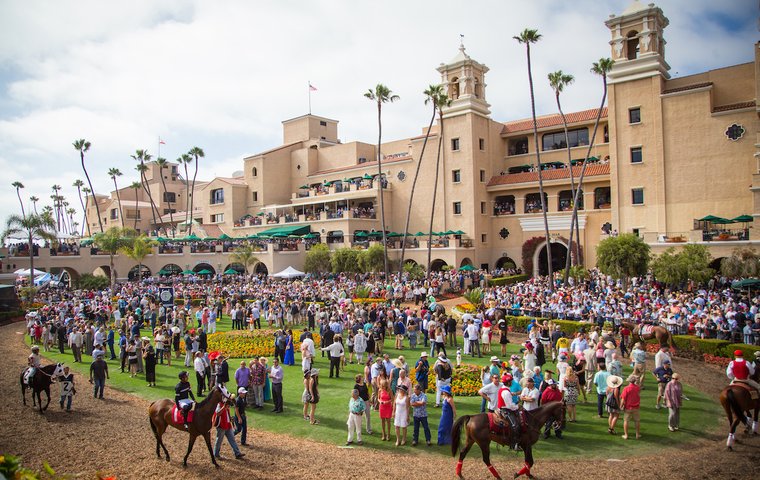
With the hugely popular summer meet only days away, Rachel Pagones examines what makes Del Mar so delightful
There is something of The Wizard of Oz in a day at Del Mar – fittingly, for a racetrack steeped since the day of its inception in Hollywood lore. Mornings are monochrome, light brown adobe buildings matching the earth, the coastal marine layer keeping a lid on the rising sun.
Come afternoon, the track is pure technicolor: palm trees and tropical flowers are in abundance under a brilliant blue sky, while the grassy parade ring swells with owners in their summer finest; jockeys sport an extraordinarily creative range of silks as horses shined to a polish stride around them.
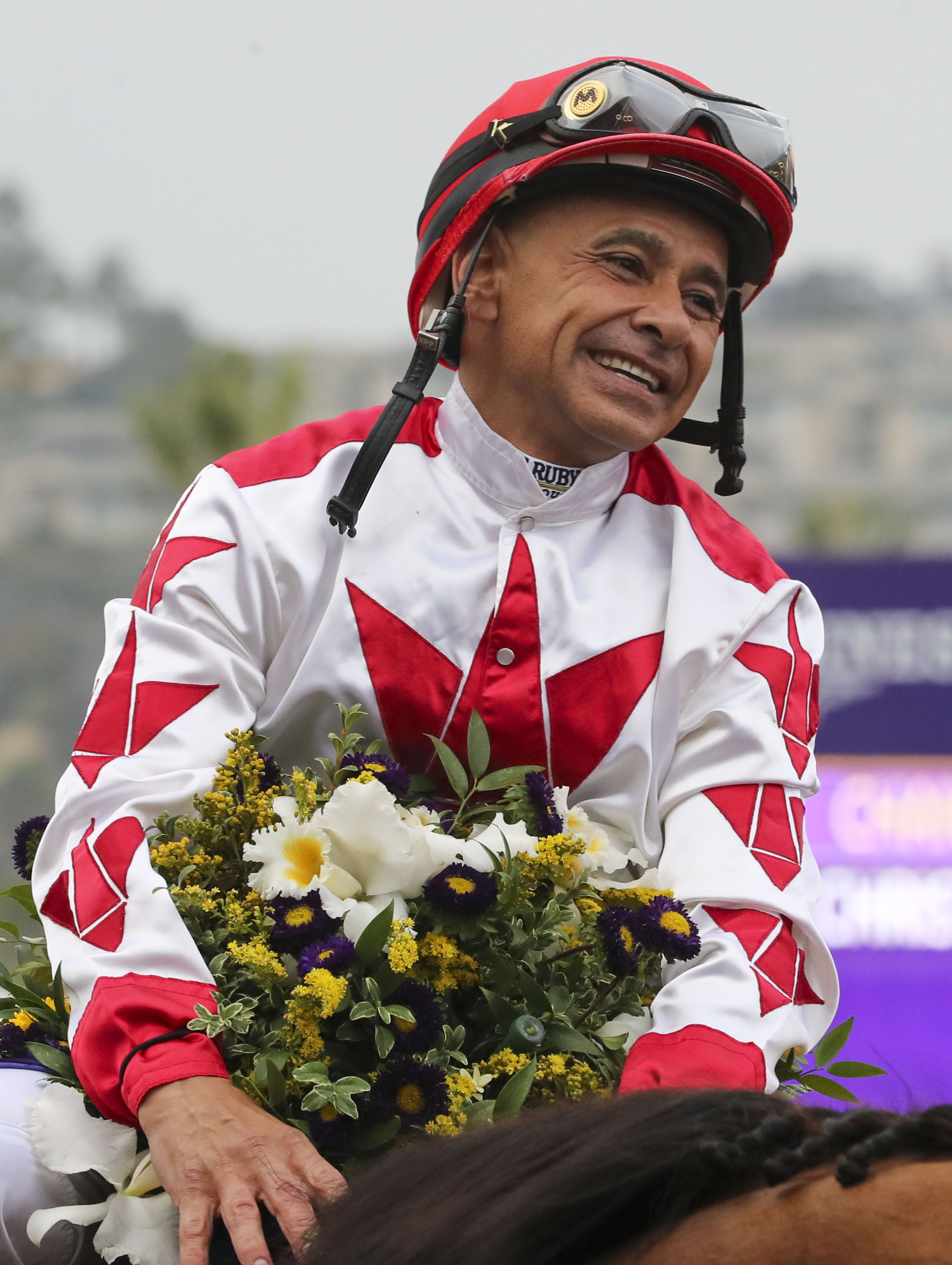 “It’s a big social scene – it’s huge,” says jockey Mike Smith, who has seen some scenes in his 40 years of riding, including 27 Breeders’ Cup wins, the US Triple Crown, and an Irish 2,000 Guineas and Dubai World Cup for good measure. “Everyone comes all dressed up to the nines – you see it all here, you see it all, especially on opening day.”
“It’s a big social scene – it’s huge,” says jockey Mike Smith, who has seen some scenes in his 40 years of riding, including 27 Breeders’ Cup wins, the US Triple Crown, and an Irish 2,000 Guineas and Dubai World Cup for good measure. “Everyone comes all dressed up to the nines – you see it all here, you see it all, especially on opening day.”
Crowded around the ring on descending levels of steps are fans in all kinds of wear, from just-off-the-beach casual to going-out-tonight glittery. They arrive in throngs, some stepping off double-decker buses doing ferry duty from Solana Beach train station a mile up Coast Highway 101. Bustling along the last stretch of pavement leading to the entry gates, you could almost kick up your heels a la Judy Garland and friends.
Indeed, Del Mar in the minds of racegoers and racing professionals alike is a respite from the humdrum of daily life – not to mention the heat of summer. “There’s a buzz around Del Mar every day,” says David Jerkens, Del Mar’s racing secretary. “The vibe of people just enjoying themselves at a place that’s literally a par 4 from the beach, is an environment that people want to be part of.”
“It’s just such a joyful place – the restaurants, the beaches, everything’s just a big vacation meet,” affirms trainer Howard Zucker, who first brought horses to Del Mar 40 years ago.
Then there’s the weather. Where else can you expect consistently sunny days with moderate temperatures? “Here’s what we’re spoiled with,” says Jerkens. “The ocean, the ocean breeze, and mid-70s every day.”
Comparison with Saratoga as a high-class, historic, ephemeral summer meeting where people take their holidays is inevitable. Smith calls the two “apples and oranges, both the two best places to be at this time of year.”
SPECIAL FEATURE: America’s favorite racetrack – but just what makes Saratoga so great?
Zucker has this to say. “It’s kind of like the Saratoga of the west [although] I don’t know why they compare it that way, because Saratoga’s been around a little longer. But the weather is so much better in Del Mar. It’s not hot, it’s not humid – the thermometer stays between 68 and 80 the whole meet.”
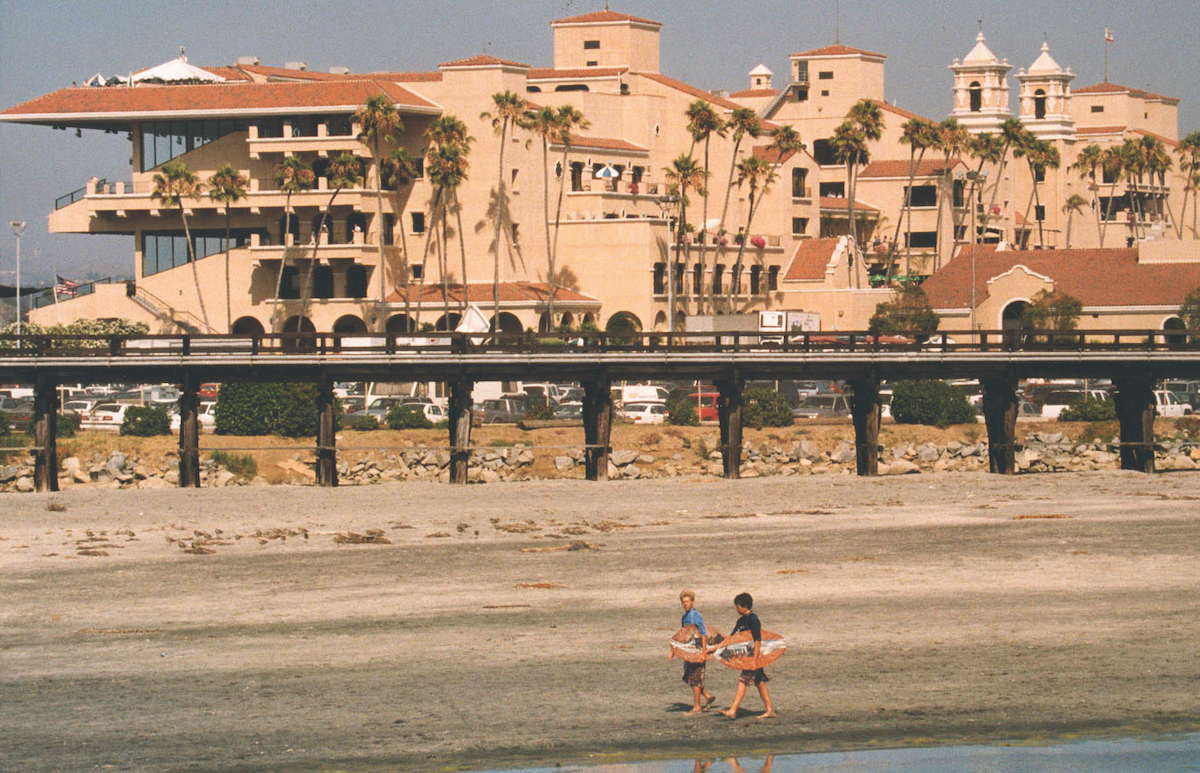 So Del Mar is not Saratoga and the weather is better. Comparisons being mostly odious anyway, we can move on to what Del Mar is, and what gives it that feeling of levity and anticipation – like the first day of summer vacation, every day.
So Del Mar is not Saratoga and the weather is better. Comparisons being mostly odious anyway, we can move on to what Del Mar is, and what gives it that feeling of levity and anticipation – like the first day of summer vacation, every day.
The racetrack, in San Diego’s North County, was founded in 1937, with Bing Crosby playing host at the gate. Within a handful of years, the Hollywood shimmer increased with star visitors including Ava Gardner, Don Ameche, Dorothy Lamour, Pat O’Brien, and W.C. Fields. Later Desi and Luci, Betty Grable, Mickey Rooney, and Jimmy Durante made appearances, the latter’s so regular that as anyone familiar with Del Mar knows, one of the two main entrances to the track is off Jimmy Durante Boulevard, while grass racing takes place on the Jimmy Durante Turf Course.
The prospect of joy, fun, and fine weather every day at the beach drew crowds then and draws them now. That alone makes Del Mar stand apart in the era of OTBs and racinos. And it acts as a positive feedback loop, drawing more trainers, owners, jockeys and fans who feast on the excitement.
“There’s nothing like a racetrack that’s full to the rafters, the noise that comes out of it,” says Zucker. “I can remember winning the first race of the meet. And the buzz is uncontrollable, the rush you get from winning, especially the first race on opening day. They’re sticking cameras in your face, interviewing you like it was the Kentucky Derby.”
The ocean figures heavily in descriptions of Del Mar. Or no, it figures lightly, an evocative tang on the wind, a cool caress on a sun-warmed shoulder. The ocean is always there, and it’s so close.
“Well if you’ve never seen it you just have to come out and see it,” says Smith. “The ocean’s right there – if you don’t turn left [on the racecourse] you literally run straight into it.”
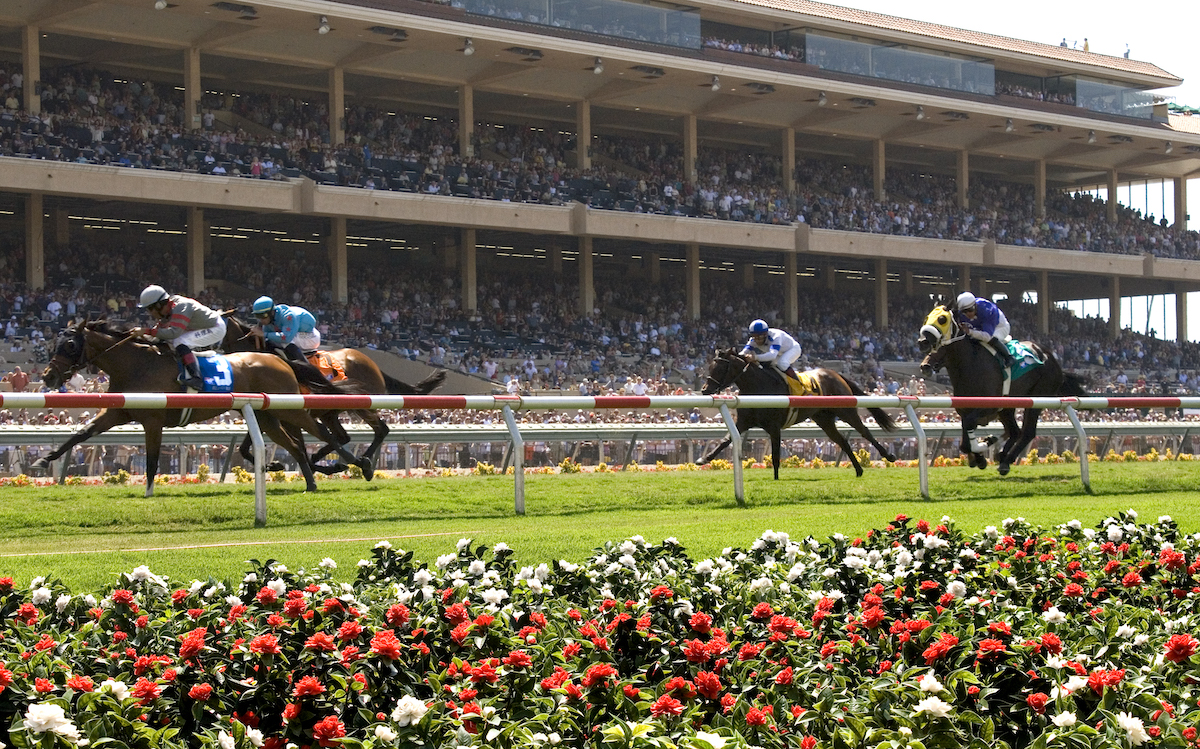 Even in the heat of a race, the Pacific remains a balmy presence. “Especially when you’re running in a race that’s a lot of ground, with lots of turns,” he adds, “because you warm up back there by the beach – I mean you’re literally looking at the water, a cool breeze is coming off the ocean, and it’s amazing.”
Even in the heat of a race, the Pacific remains a balmy presence. “Especially when you’re running in a race that’s a lot of ground, with lots of turns,” he adds, “because you warm up back there by the beach – I mean you’re literally looking at the water, a cool breeze is coming off the ocean, and it’s amazing.”
There is one form of intense heat at Del Mar – the fire of competition. “Down there, it is tough to win a race,” says Zucker, who spends most of his year at Santa Anita and has won his share by the seaside.
“People come and they drop their horse into really competitive spots in order to win. The claim box is full of slips – any time there’s a horse that even has a shot, there’ll be 20, 30 claims on several horses in every race. Everybody wants to win a race at Del Mar, the owners especially.”
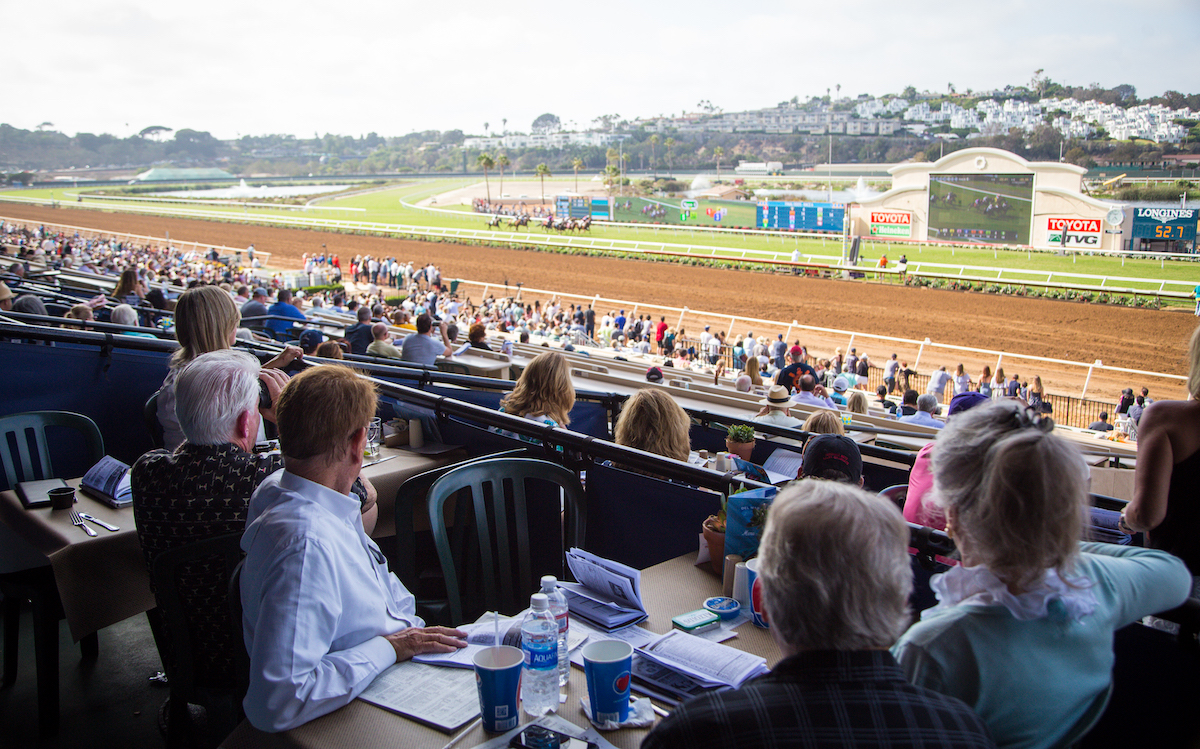 Bolstering the competition is the track’s Ship and Win program. Now in its 12th year, the incentive offers an appearance bonus as well as enhanced prize money for horses from out of state. While the appearance bonus ($5,000 for dirt races and $4,000 for turf races) is for the first race only, a prize-money boost of 50% for overnight dirt races and 40% for turf continues through the entire meeting, leading to a significant uptick in runners. Last summer the program added 160 horses contributing to over 200 starts, which helped produce a robust average field size of 8.5 horses.
Bolstering the competition is the track’s Ship and Win program. Now in its 12th year, the incentive offers an appearance bonus as well as enhanced prize money for horses from out of state. While the appearance bonus ($5,000 for dirt races and $4,000 for turf races) is for the first race only, a prize-money boost of 50% for overnight dirt races and 40% for turf continues through the entire meeting, leading to a significant uptick in runners. Last summer the program added 160 horses contributing to over 200 starts, which helped produce a robust average field size of 8.5 horses.
Your average Del Mar racegoer arguably does not make much distinction between a claiming race and a stakes race, as long as the race is competitive. Which is not to say the track is bereft of top-class horses and Graded stakes, most notably the $1m G1 Pacific Classic, the summer meet’s showpiece. For jockeys, owners, and trainers, as Mike Smith says, “it’s just extra-special to win here. You’ve got the best of the best all gathered for this month and a half here at Del Mar, so you know you’ve beaten the best there is around here.”
In Smith’s case, that includes four Pacific Classic victories, beginning with Came Home in 2002, as well as Zenyatta’s historic three-peat in the G1 Clement L. Hirsch Stakes. Zenyatta’s is one of many equine ghosts inhabiting the Del Mar stretch – indeed she is easy to envision, extending her long forelegs and pointing her hooves exuberantly as she parades to post.
There are so many others, from scrappy Seabiscuit to graceful Tomy Lee to the iron-hard South American-imports Bayakoa, Paseana and Candy Ride, all trained by Ron McAnally.
There is Cigar, his back matching his front, top matching the bottom, in the words of trainer Bill Mott – the end result sublime in its balance – stepping out for his morning workout, the track for once empty as all others have been banned ahead of the Horse of the Year’s exercise en route to a bid for history. (Indelibly, Cigar’s 16-race win streak was broken in the 1996 Pacific Classic before a then-record crowd of 44,181.)
One might also hear the ghost of trainer Charlie Whittingham, beating even the grooms to the barn at 3.30 am, avowing, “I’ll have plenty of time to sleep when I’m dead.” And that wavery rendition of ‘Where the Turf Meets the Surf’ – could that be Bing Crosby, circa 1945, heralding the re-opening of Del Mar after three years of closure during World War II?
One thing is for sure: the ocean has abided through it all. And when the races are over, the waves will continue to break, susurrating that win or lose, tomorrow is another day, and the sun will drop into the Pacific. “There’s nothing like the sunsets,” says Zucker. “Sunset over Moonlight Beach – I’ll take that over anyplace I’ve ever been.”
• Visit the Del Mar website
Special feature: America’s favorite racetrack – but just what is it that makes Saratoga so great?
Sister Dot: the Secretariat mare who outdid herself by producing a champion
Charles Hayward: Good things are happening at the National Museum of Racing and Hall of Fame
Like father, like son: Riley Mott set to launch training career in his own right
What They're Thinking: Jenine Sahadi – We need to stop with the lying and the hypocrisy
View the latest TRC Global Rankings for horses / jockeys / trainers / sires


